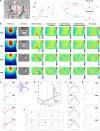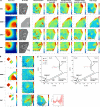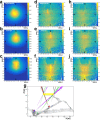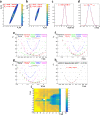Precise characterization of a corridor-shaped structure in Khufu's Pyramid by observation of cosmic-ray muons
- PMID: 36864018
- PMCID: PMC9981702
- DOI: 10.1038/s41467-023-36351-0
Precise characterization of a corridor-shaped structure in Khufu's Pyramid by observation of cosmic-ray muons
Abstract
Khufu's Pyramid is one of the largest archaeological monument all over the world, which still holds many mysteries. In 2016 and 2017, the ScanPyramids team reported on several discoveries of previously unknown voids by cosmic-ray muon radiography that is a non-destructive technique ideal for the investigation of large-scale structures. Among these discoveries, a corridor-shaped structure has been observed behind the so-called Chevron zone on the North face, with a length of at least 5 meters. A dedicated study of this structure was thus necessary to better understand its function in relation with the enigmatic architectural role of this Chevron. Here we report on new measurements of excellent sensitivity obtained with nuclear emulsion films from Nagoya University and gaseous detectors from CEA, revealing a structure of about 9 m length with a transverse section of about 2.0 m by 2.0 m.
© 2023. The Author(s).
Conflict of interest statement
The authors declare no competing interests.
Figures








References
-
- Tanaka H, et al. Development of an emulsion imaging system for cosmic-ray muon radiography to explore the internal structure of a volcano, Mt. Asama. Nucl. Instrum. Methods Phys. Res. A. 2007;575:489–497. doi: 10.1016/j.nima.2007.02.104. - DOI
-
- Morishima, K. et al. First demonstration of cosmic ray muon radiography of reactor cores with nuclear emulsion based on an automated high-speed scanning technology. Proc. 26th Workshop on ‘Radiation Detectors and Their Uses’27–36 (2012).
-
- Fujii H, et al. Performance of a remotely located muon radiography system to identify the inner structure of a nuclear plant. Progr. Theor. Exp. Phys. 2013;7:073C01.
-
- Procureur S. Muon imaging: Principles, technologies and applications. Nucl. Instrum. Methods Phys. Res. A. 2018;878:169–179. doi: 10.1016/j.nima.2017.08.004. - DOI
Grants and funding
- ANR-10-LABX-0038/Conseil Régional, Île-de-France (Île-de-France Regional Council)
- JP18069661/MEXT | JST | Precursory Research for Embryonic Science and Technology (PRESTO)
- JP18H03470/MEXT | Japan Society for the Promotion of Science (JSPS)
- JP21H05086/MEXT | Japan Society for the Promotion of Science (JSPS)
- JP15H04241/MEXT | Japan Society for the Promotion of Science (JSPS)
LinkOut - more resources
Full Text Sources

